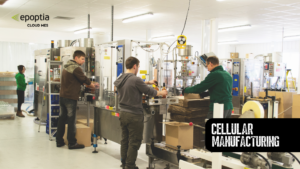Ανακαλύψτε γιατί τα καταστήματα εργασίας πρέπει να μετρούν την αποδοτικότητα αντί να κυνηγούν αριθμούς OEE
Κατ' αρχάς, όταν πρόκειται για τη μέτρηση της απόδοσης, οι περισσότεροι κατασκευαστές ενστικτωδώς εξετάζουν OEE (Συνολική αποτελεσματικότητα εξοπλισμού). Είναι ένας καθιερωμένος δείκτης μέτρησης στη μαζική παραγωγή, αλλά για τους κατασκευαστές εργοστασίων, ο OEE συχνά δημιουργεί περισσότερη σύγχυση παρά σαφήνεια.
Γιατί; Επειδή τα εργοστάσια δεν λειτουργούν όπως τα εργοστάσια αυτοκινήτων ή οι γραμμές παραγωγής μεγάλης κλίμακας. Ασχολούνται με Μικρές σειρές, συχνές αλλαγές και παραγγελίες υψηλής προσαρμοστικότητας. Σε ένα τέτοιο περιβάλλον, το OEE μπορεί να δώσει παραπλανητικά αποτελέσματα που δεν αντικατοπτρίζουν την πραγματική απόδοση ή κερδοφορία.
Αυτός είναι ο λόγος για τον οποίο όλο και περισσότεροι κατασκευαστές που χρησιμοποιούν το Epoptia MES στρέφονται προς μια απλούστερη, πιο εφαρμόσιμη μέτρηση: Δείκτης απόδοσης KPI.
Γιατί το OEE δεν ταιριάζει στην πραγματικότητα του Job Shop
Πρώτα απ' όλα, το OEE είναι χρήσιμο όταν παράγετε χιλιάδες πανομοιότυπα εξαρτήματα με ελάχιστες διακυμάνσεις. Αλλά στα εργοστάσια, τα πράγματα είναι πολύ διαφορετικά. Ας αναλύσουμε τους κύριους λόγους για τους οποίους το OEE αποτυγχάνει να αποτυπώσει την πραγματική απόδοση του εργαστηρίου:
1. Συχνές αλλαγές
Στη μαζική παραγωγή, οι ρυθμίσεις συμβαίνουν σπάνια. Αλλά στα εργοστάσια, μπορεί να συμβαίνουν αρκετές φορές την ημέρα. Το OEE συχνά το τιμωρεί αυτό ως χρόνο διακοπής λειτουργίας, μειώνοντας τη βαθμολογία απόδοσης, παρόλο που οι ρυθμίσεις είναι ένα φυσιολογικό, προστιθέμενης αξίας μέρος της ροής εργασίας σας.
2. Μικρά μεγέθη παρτίδας
Το OEE λειτουργεί καλύτερα για χιλιάδες πανομοιότυπα εξαρτήματα. Αλλά αν παράγετε 20, 50 ή 100 μοναδικά εξαρτήματα ανά πελάτη, τα ποσοστά διαθεσιμότητας και χρήσης δεν αντιπροσωπεύουν την πραγματική παραγωγικότητα.
Ένας πελάτης της Epoptia που δραστηριοποιείται στην κατεργασία ακριβείας το είπε με τον καλύτερο τρόπο:
“Αισθανόμασταν αποτυχημένοι σύμφωνα με το OEE, ακόμη και τις ημέρες που πετύχαμε κάθε προθεσμία παράδοσης”.”
3. Πολύπλοκοι παράγοντες ποιότητας
Στα εργοστάσια, η “ποιότητα” υπερβαίνει τα απορρίμματα ή την επανεπεξεργασία. Μπορεί να σημαίνει ανοχές, φινιρίσματα ή παραλλαγές σχεδιασμού. Οι άκαμπτοι τύποι του OEE δεν λαμβάνουν υπόψη αυτή την πολυπλοκότητα, καθιστώντας δύσκολη τη σύνδεση του δείκτη KPI με την παραγωγή στον πραγματικό κόσμο.
Γιατί ο KPI αποδοτικότητας ταιριάζει καλύτερα στα καταστήματα εργασίας
Συνεχίζοντας, αντί να προσπαθούν να προσαρμόσουν με το ζόρι μια μετρική που έχει σχεδιαστεί για εργοστάσια αυτοκινήτων, τα εργοστάσια χρειάζονται μια μετρική που να αντικατοπτρίζει τον πραγματικό ρυθμό λειτουργίας τους. Αυτό ακριβώς κάνει ο δείκτης αποδοτικότητας KPI.
Η αποτελεσματικότητα απαντά σε ένα ισχυρό ερώτημα:
Πόσο ονομαστικό χρόνο είχε η εργασία αν ολοκληρωθεί, σε σύγκριση με το πόσες ώρες είχαν προγραμματιστεί;
Αυτή η σύγκριση καθιστά τον δείκτη απόδοσης πρακτικό, διαφανές και οικονομικά διορατικό μετρικό.
Ας δούμε γιατί λειτουργεί τόσο καλά για τα καταστήματα εργασίας:
1. Άμεση σύνδεση με τη διαχείριση του κόστους
Συγκρίνοντας τον ονομαστικό χρόνο με τον προγραμματισμένο χρόνο, βλέπετε αμέσως αν μια εργασία καταναλώνει περισσότερους πόρους από τους αναμενόμενους. Αυτό σημαίνει ότι μπορείτε να παρακολουθείτε την ημερήσια κερδοφορία σε πραγματικό χρόνο, κατανοώντας ποιες εργασίες δημιουργούν περιθώριο κέρδους και ποιες το διαβρώνουν.
2. Δίκαιη μέτρηση για ομάδες
Η αποδοτικότητα επικεντρώνεται σε προγραμματισμένα σημεία αναφοράς, διασφαλίζοντας ότι οι χειριστές δεν τιμωρούνται άδικα για νόμιμες αλλαγές, πολύπλοκες ρυθμίσεις ή αναγκαίες προσαρμογές. Ανταμείβει την παραγωγικότητα με βάση τις πραγματικές συνθήκες και όχι τα μη ρεαλιστικά πρότυπα OEE.
3. Αξιοποιήσιμες γνώσεις
Όταν μια εργασία αποκλίνει από τον ονομαστικό της χρόνο, οι διαχειριστές μπορούν να εντοπίζουν αμέσως τα σημεία συμφόρησης, είτε πρόκειται για ένα βήμα της διαδικασίας, είτε για ένα συγκεκριμένο μηχάνημα, είτε για μια καθυστέρηση υλικού. Τα δεδομένα αποδοτικότητας οδηγούν σε ταχύτερες, εξυπνότερες αποφάσεις.
4. SΥποστηρίζει τη συνεχή βελτίωση
Με την πάροδο του χρόνου, η παρακολούθηση της αποδοτικότητας αποκαλύπτει επαναλαμβανόμενες ανεπάρκειες και βοηθά τις ομάδες να βελτιώσουν τις διαδικασίες, να βελτιώσουν την ακρίβεια του προγραμματισμού και να μειώσουν τη σπατάλη.
Η σύνδεση καθημερινής κερδοφορίας
Τέλος, ακόμη και με ορατότητα και ένα καλό σχέδιο, υπάρχουν καθυστερήσεις εάν οι πληροφορίες δεν κοινοποιούνται άμεσα. Σε πολλά καταστήματα, ο δείκτης αποτελεσματικότητας KPI δεν είναι απλώς ένας αριθμός απόδοσης, αλλά ένας καθημερινός έλεγχος υγείας για την επιχείρησή σας.
Συγκρίνοντας ονομαστικός, προγραμματισμένος και πραγματικός χρόνος, μπορείτε να εντοπίσετε αμέσως αν κάθε εργασία συμβάλλει στο κέρδος ή τη ζημία σε μια δεδομένη ημέρα.
Συνδέει άμεσα την αποδοτικότητα της παραγωγής με τα οικονομικά αποτελέσματα.
Για παράδειγμα:
- Εάν ο πραγματικός χρόνος < προγραμματισμένος χρόνος → η εργασία εκτελείται αποτελεσματικά και προσθέτει στο ημερήσιο κέρδος.
- Εάν ο πραγματικός χρόνος > ονομαστικός χρόνος → η εργασία καταναλώνει περισσότερους πόρους, επηρεάζοντας τα ημερήσια περιθώρια.
Με το Epoptia MES, αυτή η διορατικότητα γίνεται αυτόματη και οπτική μέσω ταμπλό σε πραγματικό χρόνο. Οι διευθυντές μπορούν να δουν την κατάσταση της κερδοφορίας τους με μια ματιά - χωρίς λογιστικά φύλλα, χωρίς χειροκίνητες αναφορές.
Πώς το Epoptia MES κάνει την αποδοτικότητα μετρήσιμη
Η μέτρηση της αποδοτικότητας ακούγεται απλή, αλλά χωρίς τα κατάλληλα εργαλεία, μπορεί να είναι δύσκολο να καταγραφούν τα δεδομένα με ακρίβεια. Σε αυτό το σημείο έρχεται να βοηθήσει το Epoptia MES. Ακολουθεί ο τρόπος με τον οποίο υποστηρίζει τα εργαστήρια εργασίας:
1. Αυτόματη καταγραφή δεδομένων
Οι χειριστές καταγράφουν τους χρόνους έναρξης και λήξης των εργασιών σε πραγματικό χρόνο μέσω μιας διαισθητικής διεπαφής, χωρίς χάρτινα αρχεία καταγραφής ή εικασίες.
2. Σύγκριση προγραμματισμένης και πραγματικής κατάστασης
Το Epoptia συγκρίνει αυτόματα τα σχέδια δρομολόγησης με τους πραγματικούς χρόνους εκτέλεσης και εμφανίζει ζωντανά ποσοστά απόδοσης ανά εργασία, μηχάνημα και χειριστή.
3. Ζωντανά ταμπλό
Ανά πάσα στιγμή, μπορείτε να δείτε ποιες εργασίες εκτελούνται εγκαίρως, ποιες κινδυνεύουν και πού είναι πιο παραγωγικό το κατάστημά σας.
4. Ανάλυση επιδόσεων
Το Epoptia αναδεικνύει τα μοτίβα σε βάθος χρόνου, εντοπίζοντας εργασίες που υπερβαίνουν σταθερά τις ώρες, μηχανήματα που καθυστερούν μετά από ρυθμίσεις και χειριστές που μπορεί να χρειάζονται υποστήριξη ή εκπαίδευση.
Γιατί ο KPI αποδοτικότητας οδηγεί σε καλύτερη απόδοση παράδοσης
Στο τέλος της ημέρας, οι πελάτες σας δεν ενδιαφέρονται για τις βαθμολογίες OEE. Τους ενδιαφέρουν οι έγκαιρες παραδόσεις. Εστιάζοντας στην αποδοτικότητα, τα εργοστάσια μπορούν:
Με την υιοθέτηση των KPI αποδοτικότητας με το Epoptia, τα εργοστάσια μπορούν:
- Βελτίωση της ακρίβειας του προγραμματισμού (λιγότερες εικασίες, πιο ρεαλιστικός προγραμματισμός)
- Εντοπίστε τα σημεία συμφόρησης νωρίς (διορθώστε τα προβλήματα πριν προκαλέσουν καθυστερήσεις)
- Αύξηση της κερδοφορίας (ευθυγραμμίζοντας την τιμολόγηση με την πραγματική προσπάθεια παραγωγής)
- Ενίσχυση της ικανοποίησης των πελατών (λιγότερες χαμένες προθεσμίες, καλύτερη εμπιστοσύνη)
Και δεδομένου ότι το Epoptia ενημερώνει αυτά τα δεδομένα συνεχώς, οι διαχειριστές μπορούν να ενεργούν πριν από το οι ανεπάρκειες επηρεάζουν τις προθεσμίες ή τα περιθώρια κέρδους.
Συμπέρασμα
Συμπερασματικά, το OEE σχεδιάστηκε για επαναλαμβανόμενη, μεγάλης κλίμακας παραγωγή, και όχι η δυναμική πραγματικότητα των σύγχρονων εργοστασίων εργασίας. Για ευέλικτα, προσαρμοσμένα περιβάλλοντα, Δείκτης απόδοσης KPI προσφέρει μια πιο ακριβή, δίκαιη και οικονομικά ουσιαστική εικόνα των επιδόσεων.
Με EPOPTIA MES,, η παρακολούθηση των KPI αποδοτικότητας γίνεται χωρίς κόπο:
- Είναι σε πραγματικό χρόνο, όχι αναδρομικά.
- Είναι οικονομικά συνδεδεμένη, όχι αφηρημένη.
- Και το πιο σημαντικό, είναι αξιοποιήσιμη.
Το αποτέλεσμα;
Μεγαλύτερη ορατότητα, πιο έξυπνες αποφάσεις, μεγαλύτερα κέρδη και πιο ευτυχισμένοι πελάτες.
Είστε έτοιμοι να μετρήσετε αυτό που πραγματικά έχει σημασία; Επικοινωνήστε μαζί μας σήμερα για να δείτε πώς η Epoptia μπορεί να μεταμορφώσει την απόδοσή σας.
Κάντε κράτηση για μια παρουσίαση επίδειξης τώρα και να το δείτε σε δράση.
Για περισσότερες πληροφορίες, δείτε https://bit.ly/3vYnb4f.
Το OEE λειτουργεί καλύτερα για μαζική παραγωγή με μεγάλες σειρές και ελάχιστες αλλαγές. Τα καταστήματα εργασίας, με συχνές ρυθμίσεις και μικρές παρτίδες, καταλήγουν σε παραπλανητικά χαμηλές βαθμολογίες OEE.
Η αποδοτικότητα μετρά τον λόγο του προγραμματισμένου χρόνου παραγωγής προς τον πραγματικό χρόνο παραγωγής. Δείχνει πόσο αποτελεσματικά εκτελέστηκε κάθε εργασία ή διαδικασία σε σύγκριση με τις προσδοκίες.
Ναι, αλλά η αποδοτικότητα θα δώσει συνήθως πιο εφαρμόσιμες πληροφορίες για εργαστήρια, ενώ το OEE μπορεί να βοηθήσει στη συγκριτική αξιολόγηση συγκεκριμένων μηχανημάτων σε επαναλαμβανόμενες διαδικασίες.
Καταγράφει τους χρόνους εκκίνησης/διακοπής από τους χειριστές σε πραγματικό χρόνο, τους συγκρίνει με τα δρομολόγια και εμφανίζει ζωντανά ποσοστά αποδοτικότητας για εργασίες, μηχανήματα και εργαζόμενους.










